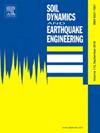循环单剪作用下再固结对砂土再液化行为的影响:三维离散元视角
IF 4.2
2区 工程技术
Q1 ENGINEERING, GEOLOGICAL
引用次数: 0
摘要
在实际工程中,砂土可能发生不止一次的地震液化。低渗透土层(如粘土层和粉质层)的存在,可能会阻碍主震液化后砂土内部超孔隙压力的消散(或再固结),从而削弱砂土在余震作用下的再液化阻力。为进一步深入了解震后再固结砂土再液化阻力降低的细观力学机制,对不同再固结程度的颗粒试件进行了一系列不排水循环单剪试验离散元模拟。在第一次(主震)和第二次(余震)循环剪切过程中,通过基于接触法向的织物张量量化了颗粒试件的承载结构演变。细观结构演化与外部载荷之间的相互作用可以很好地解释余震过程中再液化阻力的降低。本文章由计算机程序翻译,如有差异,请以英文原文为准。
Influence of reconsolidation on the reliquefaction behavior of sand under cyclic simple shear: A 3D discrete element perspective
In practical engineering, earthquake-induced liquefaction can occur more than once in sandy soils. The existence of low-permeable soil layers, such as clay and silty layers in situ, may hinder the dissipation of excess pore pressure within sand (or reconsolidation) after the occurrence of liquefaction due to the mainshock and therefore weaken the reliquefaction resistance of sand under an aftershock. To gain more mesomechanical insights into the reduced reliquefaction resistance of the reconsolidated sand under aftershock, a series of discrete element simulations of undrained cyclic simple shear tests were carried out on granular specimens with different degrees of reconsolidation. During both the first (mainshock) and second (aftershock) cyclic shearing processes, the evolution of the load-bearing structure of the granular specimens was quantified through a contact-normal-based fabric tensor. The interplay between mesoscopic structure evolutions and external loadings can well explain the decrease in reliquefaction resistance during an aftershock.
求助全文
通过发布文献求助,成功后即可免费获取论文全文。
去求助
来源期刊

Soil Dynamics and Earthquake Engineering
工程技术-地球科学综合
CiteScore
7.50
自引率
15.00%
发文量
446
审稿时长
8 months
期刊介绍:
The journal aims to encourage and enhance the role of mechanics and other disciplines as they relate to earthquake engineering by providing opportunities for the publication of the work of applied mathematicians, engineers and other applied scientists involved in solving problems closely related to the field of earthquake engineering and geotechnical earthquake engineering.
Emphasis is placed on new concepts and techniques, but case histories will also be published if they enhance the presentation and understanding of new technical concepts.
 求助内容:
求助内容: 应助结果提醒方式:
应助结果提醒方式:


